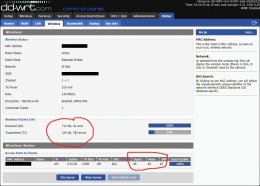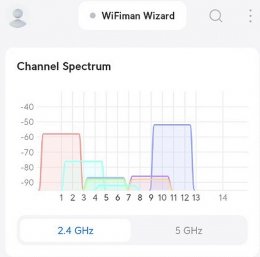Mickey D
2024-01-28 05:32:22 UTC
I'm relatively new to wireless networking & ask you for debug advice.
Everything is working but there are errors I'm trying to figure out.
Loading Image...
Where that "wireless bridge client repeater" is bridged 1:1 to an
access point which happens to be on the non-overlapping channel 11.
The debug took I'm using on Android to find the noise sources is this.
https://play.google.com/store/apps/details?id=com.ubnt.usurvey
But of course, that only records Wi-Fi sources, not all nearby radios.
Loading Image...
While that only shows wi-fi interference sources, there are
no baby monitors nearby that I know of. No microwave in use.
No airport nearby. No doorbell cameras. Nothing that I know of.
Even the phone, connected to that same channel 11 access point
shows a steady downarrow of 390Mbps but the uparrow flips every
few seconds between 433Mbps and 6Mbps (consistently the same numbers).
Loading Image...
While I'm not at all sure what that even means for the uparrow to
be flipping between over 400Mbps and less than 10 Mbps, below are
the basic wireless settings of the bridge connected to the desktop.
1. Desktop PC 1 floor from the main router has no Wi-Fi. Only Ethernet.
2. So I plugged an old Netgear WNR834Bv2 into that Ethernet RJ45.
3. And I installed DD-WRT onto that Netgear WNR834Bv2 & set it up as
Setup | Advanced Routing | Operating Mode = Router
Setup | Basic Setup | WAN Connection Type = Disabled
Wireless | Basic Settings | Radio Mode = Repeater Bridge
Wireless | Basic Settings | Network Configuration = Bridged
How do I debug the high transmission error rate?
Status | Wireless | Wireless Packet Info | Received (RX) = 100%
Status | Wireless | Wireless Packet Info | Transmitted (TX) = 14%
And how do I investigate the source of this continued interference?
Status | Wireless | Access Points & Clients | Signal = -38 dBm
Status | Wireless | Access Points & Clients | Noise = -81 dBm
Status | Wireless | Access Points & Clients | SNR = 43
There are a few questions related to how do I debug?
a. What Android tool will find noise sources _outside_ Wi-Fi channels?
b. How do I test for where all that noise is coming from?
c. Why am I receiving all but losing almost all my bridge packets?
Everything is working but there are errors I'm trying to figure out.
Loading Image...
Where that "wireless bridge client repeater" is bridged 1:1 to an
access point which happens to be on the non-overlapping channel 11.
The debug took I'm using on Android to find the noise sources is this.
https://play.google.com/store/apps/details?id=com.ubnt.usurvey
But of course, that only records Wi-Fi sources, not all nearby radios.
Loading Image...
While that only shows wi-fi interference sources, there are
no baby monitors nearby that I know of. No microwave in use.
No airport nearby. No doorbell cameras. Nothing that I know of.
Even the phone, connected to that same channel 11 access point
shows a steady downarrow of 390Mbps but the uparrow flips every
few seconds between 433Mbps and 6Mbps (consistently the same numbers).
Loading Image...
While I'm not at all sure what that even means for the uparrow to
be flipping between over 400Mbps and less than 10 Mbps, below are
the basic wireless settings of the bridge connected to the desktop.
1. Desktop PC 1 floor from the main router has no Wi-Fi. Only Ethernet.
2. So I plugged an old Netgear WNR834Bv2 into that Ethernet RJ45.
3. And I installed DD-WRT onto that Netgear WNR834Bv2 & set it up as
Setup | Advanced Routing | Operating Mode = Router
Setup | Basic Setup | WAN Connection Type = Disabled
Wireless | Basic Settings | Radio Mode = Repeater Bridge
Wireless | Basic Settings | Network Configuration = Bridged
How do I debug the high transmission error rate?
Status | Wireless | Wireless Packet Info | Received (RX) = 100%
Status | Wireless | Wireless Packet Info | Transmitted (TX) = 14%
And how do I investigate the source of this continued interference?
Status | Wireless | Access Points & Clients | Signal = -38 dBm
Status | Wireless | Access Points & Clients | Noise = -81 dBm
Status | Wireless | Access Points & Clients | SNR = 43
There are a few questions related to how do I debug?
a. What Android tool will find noise sources _outside_ Wi-Fi channels?
b. How do I test for where all that noise is coming from?
c. Why am I receiving all but losing almost all my bridge packets?